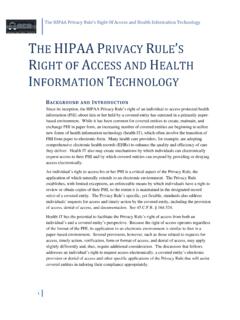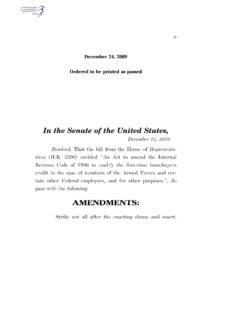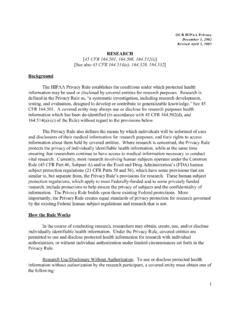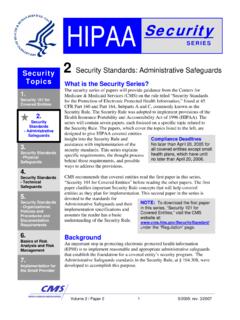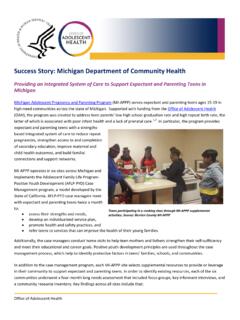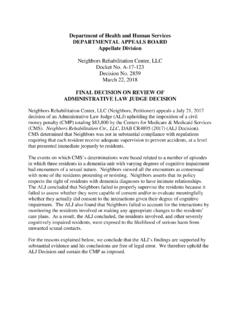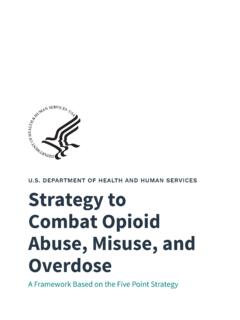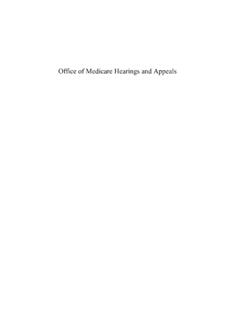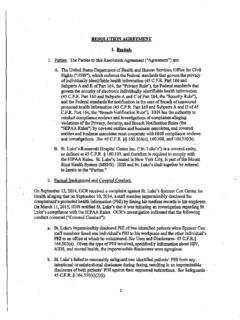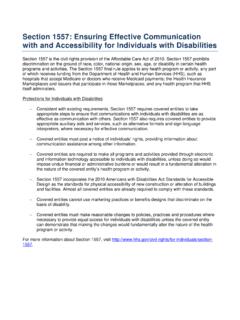Transcription of Public Health and Social Services Emergency Fund
1 DEPARTMENT. of Health . and HUMAN. Services . Fiscal Year 2023. Public Health and Social Services Emergency Fund Justification of Estimates for Appropriations Committee Public Health and Social Services Emergency Fund TABLE OF CONTENTS. Organization Charts .. 9. Assistant Secretary for Preparedness and Response .. 9. Cybersecurity .. 11. Office of National Security .. 12. Introduction and Mission .. 13. Overview of Budget Request .. 15. Overview of Performance .. 19. All Purpose Table .. 23. Appropriations 24. FY 2023 Appropriations 24. FY 2023 General Provision .. 25. Appropriations Language Analysis .. 26. Summary of Changes .. 27. Budget Authority by Activity .. 28. Authorizing Legislation .. 29. Appropriations History .. 30. Appropriations Not Authorized by Law .. 32. Assistant Secretary for Preparedness and Response.
2 33. Summary of Request .. 33. Pandemic Preparedness .. 36. Preparedness and Emergency Operations .. 40. National Disaster Medical System .. 50. Medical Reserve Corps .. 61. Hospital Preparedness Program .. 65. Preparedness and Response Innovation .. 83. Biomedical Advanced Research and Development 85. Project BioShield .. 105. Strategic National Stockpile .. 111. Policy and Planning .. 127. Operations .. 135. HHS Coordination Operations and Response Element .. 140. Assistant Secretary for Administration .. 142. Cybersecurity .. 142. Department of Health and Human Services .. 153. Other PHSSEF Cybersecurity HHS 153. Immediate Office of the Secretary .. 155. 2. Public Health and Social Services Emergency Fund Office of National Security .. 155. Pandemic 158. Assistant Secretary for Health .. 172. Commissioned Corps Readiness Training.
3 172. Public Health Service Ready 174. Public Health and Emergency Response Strike Team .. 177. IDEA Digital Modernization Act .. 179. Budget Authority by Object Class .. 180. Salaries and Expenses .. 181. Detail of Full-Time Equivalent Employment .. 182. Detail of Positions .. 183. Programs Proposed for Elimination .. 184. Proposed 185. Direct Hire Authority .. 185. Extension of National Disaster Medical System Direct Hire Authority .. 186. Significant Items in Appropriation Committee Reports .. 187. 3. Public Health and Social Services Emergency Fund We are pleased to present the Fiscal Year (FY) 2023 Congressional Justification for the Public Health and Social Services Emergency Fund (PHSSEF). The FY 2023 Budget Request directly supports the United States' ability to prepare for, respond to, and recover from the consequences of a wide range of natural and man-made medical and Public Health security threats and includes the FY 2023.
4 Budget justification for the Office of the Assistant Secretary for Preparedness and Response (ASPR), Cybersecurity, the Office of National Security (ONS), the Office of Global Affairs (OGA) pandemic influenza program, and the Public Health Service Commissioned Corps led by the Office of the Assistant Secretary for Health (OASH). Office of the Assistant Secretary for Preparedness and Response (ASPR). ASPR leads the nation's medical and Public Health preparedness for, response to, and recovery from natural disasters, pandemics, and other Public Health emergencies. ASPR collaborates with hospitals, Health care coalitions, biotech firms, community members, state, local, tribal, and territorial governments, and other partners across the country to improve readiness and response capabilities. ASPR leads the development, acquisition, and stockpiling of medical countermeasures such as vaccines, therapeutics, personal protective equipment, medical devices, and other resources needed during Public Health emergencies.
5 To help meet this medical countermeasure mission, in February ASPR relaunched the Public Health Emergency Medical Countermeasures Enterprise (PHEMCE) to enhance collaboration between federal, state, and local governments as well as private industry, nonprofits, academia, and other partners. ASPR also deploys National Disaster Medical System (NDMS) response teams to states and territories during or following disasters to bolster the local response. And through the Medical Reserve Corps, ASPR supports the mobilization of volunteer units to assist in communities' Public Health needs such as vaccination clinics, blood donations, and more. During the COVID-19 response, ASPR expanded its impact in many ways, perhaps most notably by establishing a coordinated operations and response element within ASPR and investing significantly in industrial base expansion and increased domestic manufacturing of key materials and capability.
6 The Assistant Secretary for Preparedness and Response leads the ASPR organization and, at the direction of the HHS Secretary, serves as COVID-19 coordinator for HHS. In this capacity, ASPR coordinates among multiple HHS agencies and other federal partners on many aspects of the pandemic response. In addition to this coordination role, ASPR has led the Administration's efforts to make available vaccines, therapeutics, masks, and tests to the American people free of charge. ASPR has also deployed hundreds of NDMS team members to support hospitals during the Delta and Omicron surges. ASPR, through the Biomedical Advanced Research and Development Authority (BARDA) supported the development of many of the vaccines, therapeutics, and tests that are available today to respond to COVID-19. BARDA directly supported seven vaccine candidates including Moderna and Johnson &.
7 Johnson's Janssen vaccine; 13 therapeutics, including development of the Regeneron monoclonal antibody therapeutic; 17 rapidly deployable and other technologies, including next generation technologies to administer vaccines; and 42 diagnostic tests ranging from high-throughput tests for laboratories early in the pandemic to rapid point-of-care and at-home tests. Twenty-seven BARDA- supported COVID-19 tests have received Emergency use authorization from the Food and Drug Administration. Through the HHS Coordination Operations and Response Element (H-CORE) and the prior Countermeasures Acceleration Group, ASPR has led the purchase and delivery of more than 690 million 4. Public Health and Social Services Emergency Fund doses of COVID-19 vaccines to 90,000 vaccination sites nationwide. This effort contributed to the 65%.
8 Of Americans who are now fully vaccinated. In addition, since September 2021, ASPR has distributed more than 6 million courses of therapeutics to states and territories, and federally funded Health clinics for free. ASPR played a lead role in significantly increasing access to COVID-19 testing and expanding industrial capacity to manufacture those tests. There were zero over-the-counter tests in January 2021, but by December 2021 there was capacity to manufacture more than 300 million tests per month. ASPR, in partnership with the Postal Service, has delivered free COVID-19 tests to 68 million American households that's 261 million tests via This effort is part of the Biden Administration's commitment to buy and distribute one billion free at-home tests to Americans. Over the course of the pandemic, ASPR's Strategic National Stockpile (SNS) has worked to backstop states and territories' medical supply needs, providing hundreds of millions of items to Americans in need including personal protective equipment (PPE), ventilators, pharmaceuticals, and more.
9 Since January, the SNS has delivered more than 250 million American-made N95 masks to pharmacies and community Health centers nationwide. The initiative is part of the Administration's commitment to make higher quality masks available for free to anyone who would like one. This effort represents the largest deployment by the Strategic National Stockpile to date and it's also the largest deployment of PPE in history. ASPR's Hospital Preparedness Program has invested in Health care preparedness at the hospital level for years and those investments helped coalitions of local Health care systems provide surge medical capacity throughout the COVID-19 response and remains critical to enabling the federal, state, and local coordination necessary to respond to future Public Health emergencies. Health care coalitions worked within communities to implement Health Emergency plans, including establishing COVID-specific hospital wings, reducing elective surgeries, and transferring patients within Health care systems or Health care coalitions, to provide care for a surge of patients.
10 ASPR also provided on-the-ground support to states and territories through the National Disaster Medical System (NDMS). NDMS teams made up of intermittent federal employees contain physicians, nurses, advance healthcare providers, fatality management professionals, paramedics, veterinarians, and other support staff, such as logisticians and information technology specialists. In 2021, NDMS supported 214. COVID-related missions, deploying 1,904 personnel to 31 states and territories. These teams provided hospital augmentation for critical and emergent care facilities critically depleted of resources and subject matter experts to manage medical and mortuary issues. In addition to NDMS, the civilian volunteer Medical Reserve Corps (MRC), a national network of over 300,000 volunteers, has also been supporting the COVID-19 response.
